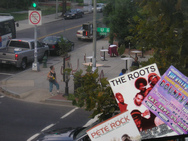“Neighborhoods are like children. They need attention differently.”
“Gentrification is a word urbanists and people in this area banter about,” said former Mayor Anthony Williams at a panel discussion last night, “but neighborhoods are like children. They need attention differently.”
No one size fits all. Williams said residents in Upper Northwest “just want services and not development.” Meanwhile across the Anacostia River, the demand is for “critical government attention,” like the big projects in the works at Saint Elizabeths and Skyland, or the recently-opened early childhood development center Educare in Parkside.
The DC Humanities Council organized the panel, which Washington City Paper editor Mike Madden moderated. Washington Post business reporter Jonathan O’Connell and Historic Preservation Review Board members Maria Casarella and Rauzia Ally joined Williams to discuss the role of public policy and economic development.
Is there a “Plan” to displace residents?
In 2003, when Williams was mayor, he set a goal of attracting 100,000 new residents over the following decade. A recent survey now shows the District is gaining people at a rate of a thousand a month.
Some in the audience expressed suspicions that this is part of a devious and covert plan to drive members of old Washington communities out of the city. Williams disputed the concept. “The notion that there is a plan may sound good, but it’s crazy,” he said, and noted that as mayor, he supported programs like the Housing Production Trust Fund to preserve affordable housing.
Offering a reality check of sorts for skeptics, O’Connell added, “Marion Barry is glad to sit down with developers.” During Barry’s mayoralty, “investments were made that were part of ‘the plan’” such as building the Verizon Center downtown and the Reeves Center at 14th & U Streets in the mid-1980s.
“The value of real estate has more of an impact than policy,” said O’Connell. “Apartments are being built on 14th Street not because of policy but because it is the best place to build apartments in the country.” Williams consented that “the market moves faster than the city.” From bike lanes to new neighborhood branch libraries, panelists and audience members agreed that public policy decisions and capital investments made years ago guide current trends.
Neighborhoods need to be involved in shaping growth
Neighborhood revitalization is at its best when residents can work with government to regenerate from within, argued Casarella. She cited the successful restoration of homes in historic Anacostia through the Office of Planning’s Historic Homeowner Grant Program as an ideal example of a working partnership between the city and neighborhood residents to direct change instead of just reacting to it.
Commercial and residential development in designated historic neighborhoods passes through Advisory Neighborhood Commissions, which receive “great weight” at the final level of agency review, said Caserella. “You are the most important planner.”
“When was the last time that ever mattered?” an audience member called out. “I have to dismiss your cynicism,” Casarella said, reflecting the overall belief of the panel that Washington’s active neighborhood level associations influence both planning and economic development.
Panelists discussed how parks can be an irreplaceable public good for a neighborhood when an audience member asked the panel to predict the future of development “east of the river which is 15 years behind what has happened on U Street.”
“It is very hard to add green space later,” O’Connell said, alluding to ongoing development in NoMA where “they missed planning a park.” With development projects either in the early stages or waiting to break ground throughout Wards 7 and 8, O’Connell cautioned residents to remain vigilant in maintaining their natural recreation space. “Poplar Point is 110 acres and 70 acres is set aside to be a park. I would be careful to make sure the 70 acres stays,” as the project slowly moves toward development.
Whereas previous conversations in the Humanities Council series have been emotionally charged, the evening’s conversation featured a more reasoned tone, with mature and insightful analysis. Most people were able to agree on at least a few things: as the city grows in population, neighborhoods will respond differently, but the best response is when residents engage constructively in the process. That gives residents both a sense of ownership over their neighborhood, and a voice in decisions that guide local development.


